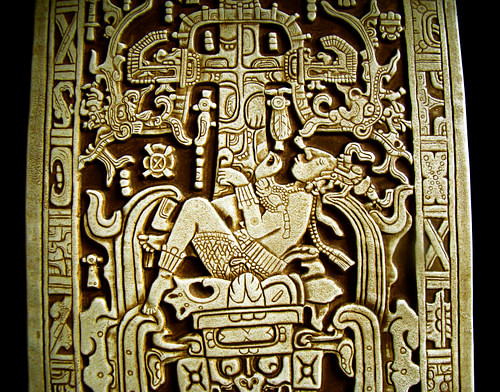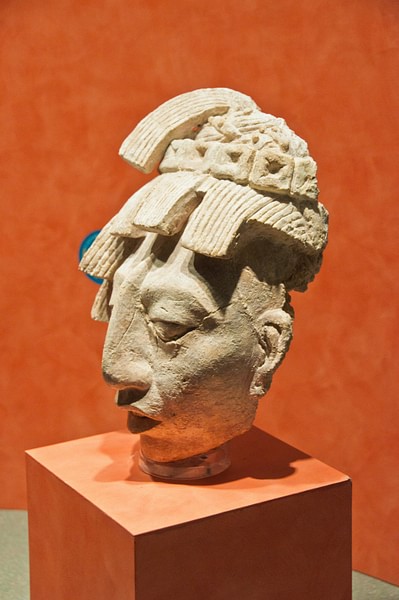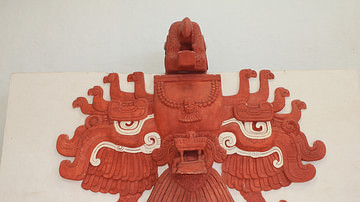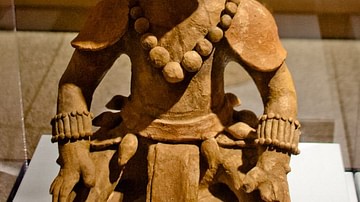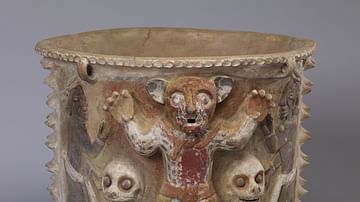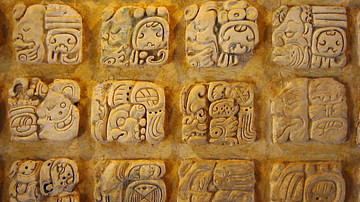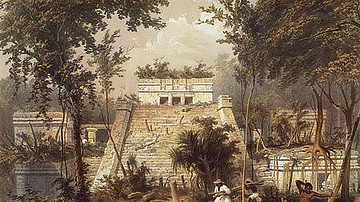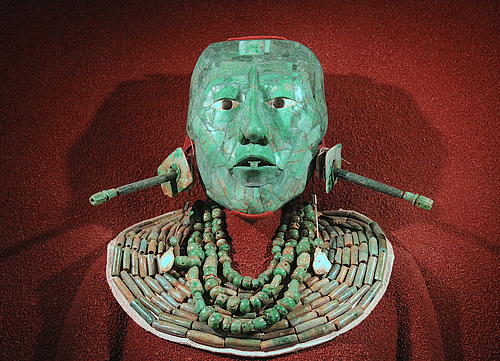
K'inich Janaab' Pakal (23 March 603 CE - 31 March 683 CE) was the Maya king of Palenque in the modern-day State of Chiapas, Mexico. Also known as Pacal (which means 'shield') and Pacal the Great, he is most famous for raising the city of Palenque (known as B'aakal) from relative obscurity to a great power, his building projects in the city (especially the Temple of the Inscriptions), and his elaborately carved sarcophagus lid which has been interpreted by some to depict an ancient astronaut riding on a rocket ship. Pacal assumed the throne of Palenque at the age of 12, in 615 CE, and ruled successfully until his death at the age of 80. He was married to the Lady Tzakbu Ajaw and had three sons who succeeded him in rule. The ruins of Palenque visible in the modern day are only a small fraction of the ancient city developed and expanded by Pacal during his reign; the rest of the vast metropolis remains unexcavated in the surrounding jungle. Palenque was a city of modest size when Pacal took the throne, and it was through his efforts that it became one of the great urban centers of Mesoamerica, rivaling even the might and splendor of Tikal.
Youth & Ascension to Power
Pacal was the son of Lady Sak K'uk who reigned as Queen of Palenque from 612-615 CE. In 611 CE the reigning king died and the legitimate heir, Pacal, was too young to take the throne. Scholars have deciphered inscriptions that make it clear that Palenque suffered a significant military defeat in 611 CE and then lost their king, Ajen Yohl Mot, the following year; this upset the balance of the city which the next ruler would need to restore. In 612 CE, Janaab Pacal, Suk K'ak's father, took the throne but died that same year. Inscriptions indicate a monarch known as Muwaan Mat assumed rule after Janaab Pacal but, as Muwaan Mat is a supernatural figure symbolizing prosperity, it is thought that this refers to the Lady Sak K'uk who returned balance to Palenque after the upheavals. She ruled for three years until her son reached maturity which, at that time, was the age of 12. The dynasty at Palenque believed that rule descended from an ancestor known as The First Mother and so female rulers, though not common, were not unusual. It was understood, however, that a female monarch would step down as soon as a male heir reached the age of maturity.
Lady Sak K'uk seems to have continued to guide her son once he took the throne, as indicated by inscriptions throughout Palenque, and she did so until her death in 640 CE. Upon taking the throne, Pacal almost instantly began building enormous and elaborately worked monuments in order to celebrate both the city's past and his family's legitimate claim to rule. The Mayanist scholar Gene Stuart writes,
Pacal emphatically traced his lineage back to a deity as well as to royal humans, and other rulers also found it wise to establish divine ancestors. A Maya ruler served as the human manifestation of gods on earth. As the intermediary between humans and gods, he claimed the power to control the supernatural forces of the universe. In rituals he nurtured and glorified the gods, seeking to maintain the always precarious balance of nature in an agricultural society (83).
Since Pacal's father was a lord, but not the king, other noble families in Palenque claimed they had more right to rule than he. In response, both Pacal and his eldest son, Kinich Kan B'alaam II, would make sure to represent the accomplishments and legitimacy of their family in all of the buildings and monuments of Palenque including the Palace, the Temples of the Cross, and the Temple of the Inscriptions.
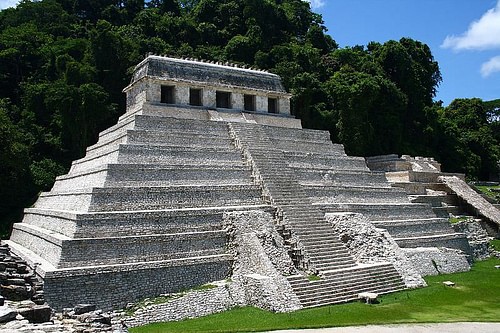
The Temple of the Inscriptions
This focus on recording the history of the city through architecture is especially notable in the famous Temple of the Inscriptions. Construction began in 675 CE and it was purposefully built as the tomb of Pacal. The Temple of the Inscriptions is a pyramid with a small building at the top inscribed with the second longest continuous Mayan text yet uncovered in Mesoamerica (the longest being the Hieroglyphic Staircase at the city of Copan). For a century after Palenque was discovered, the pyramid was thought to be a religious centre in the city (as the inscriptions were undecipherable) until the Mexican Archaeologist Alberto Ruiz recognized that the walls of the small temple continued down below the floor. He discovered that the platform of the floor had drill holes, which had been sealed by stone plugs, and surmised that the Maya had lowered the floor into place with ropes, perhaps, to seal a royal tomb. Between 1948 and 1952 CE, Ruiz worked with his team, excavating the temple and, finally, discovered the tomb of Pacal the Great. He shone his flashlight down into the tomb and, as he writes:
Out of the dim shadows emerged a vision from a fairy tale, a fantastic, ethereal sight from another world. It seemed a huge magic grotto carved out of ice, the walls sparkling and glistening like snow crystals. Delicate festoons of stalactites hung like tassels of a curtain, and the stalagmites on the floor looked like drippings from a great candle. The impression, in fact, was that of an abandoned chapel. Across the walls marched stucco figures in low relief. Then my eyes sought the floor. This was almost entirely filled with a great carved stone slab, in perfect condition.
The stone slab was the sarcophagus of Pacal which, when re
moved, revealed the great king wearing a jade mask and adorned as the Maya Maize god in jade jewelry and a beaded net skirt. The historian Clare Gibson comments on this writing,
The beaded net skirt that Pacal is wearing connects him with the Maize God who may be depicted dressed in it in scenes in which he is shown dancing out of Xibalba [the Mayan underworld]. This type of skirt was usually worn by Maya women, but adorns the Maize God to signify his powers of fertility. Pacal would have expected to have emulated the Maize God in being resurrected following his death (46).
The tomb contained a great quantity of earrings, wristlets, bracelets, and necklaces, and a jade base relief of high quality. Stuart writes, "The Maya held jade in esteem equal to quetzal plumes [the feathers of the Quetzal bird], in part because they saw in the green of both a symbol of life. The elite wore jade jewelry by the pound in necklaces, ear ornaments, bracelets, and anklets, and on belts" (101). None of the treasures, however, proved as valuable to Mayanists as the sarcophagus lid itself which depicted the Maya view of the cosmos.
Pacal's Sarcophagus & Identity Controversy
The Sarcophagus' lid measures 3.6x2 metres (12x7 feet) and shows a man tilting backwards at the base of a tree, with a bird high at the top, either falling into or springing out of what appears to be a large urn. Glyphs and symbols run around the edges of the lid, all representing important components of Mayan cosmology. Pacal's sarcophagus is what he is best known for in the modern day as ancient alien theorists, following Erich Von Daniken's interpretation in his book Chariots of the Gods, claimed the lid depicts a man riding on a rocket ship, smoke issuing from an exhaust pipe behind him, and the glyphs representing outer space. In reality, the relief shows the World Tree, which the Maya believed had its roots in the underworld, trunk on the earthly plane, and branches high in paradise, and Pacal's relationship to it in death. The king is depicted either at the moment of his death falling from the earthly plane down into Xibalba or at the moment of his resurrection from the underworld, climbing up the World Tree toward paradise. The adornments along the edges represent the sky and other glyphs the sun and moon and, still others, past rulers of Palenque and Pacal's place among them. The bird at the top of the tree is the Bird of Heaven (also known as The Celestial Bird or Principal Bird Deity) who represents the realm of the gods in this piece, and the `urn' beneath Pacal is the entrance to Xibalba. Once one is acquainted with Maya cosmological concepts, there is nothing mysterious about the lid of Pacal's sarcophagus but, in 1952 CE, scholars knew far less than they do in the modern day, and so the relief was more open to interpretation at the time when Von Daniken wrote his book (in 1968 CE) than it is today. No credible scholar in the modern day accepts the lid as depicting anything having to do with a rocket ship or an astronaut, but some writers still persist in raising debate over the interpretation of the piece.
Controversy also raged over the identity of the skeleton inside the tomb. It was found that the skeleton's teeth were in very good condition and indicated a male of around the age of 40 at the time of death. Since archaeologists knew that Pacal died at the age of 80, once they had dated the monuments and buildings constructed during his reign, the findings of the epigraphers who identified Pacal as the skeleton in the tomb were called into question. David Kelly and Floyd Lounsbury were the first epigraphers to identify the tomb as belonging to Lord Pacal of Palenque, and their work was later continued by Peter Matthews and Linda Schele. Physical anthropologists, for the most part, contended that the tomb had to belong to a younger man, and the epigraphers had made a mistake in identifying it as that of Pacal, while cultural anthropologists stood by the identification and their work. The controversy was finally resolved in 1996 CE when it was agreed that, as a nobleman all his life, Pacal would have enjoyed better food than his subjects and so his teeth would have been in better condition than others. Further, as no one knows what Pacal favored in his diet, he could have eaten softer foods that took little toll on his teeth. The fact that he lived until the age of 80, and still had a full set of teeth, argues for a healthy lifestyle and attention to personal hygiene. Today it is generally acknowledged that the tomb belongs to Pacal and the remains found by Ruiz in 1952 CE are those of the great king of Palenque.
The Decline of Palenque
The city continued to prosper under the rule of Pacal's sons and their heirs but was invaded and sacked by the forces from the city of Tonina in 711 CE. Archaeological evidence from this period shows no new building construction, and inscriptions indicate the king was captured and, perhaps, executed. There seems to have been no monarch in the city for some time after this, but it is recorded that hostilities between Tonina and Palenque continued through c. 750 CE. The cause of the war is unknown. As with other great Maya urban centers, Palenque was abandoned at some point c. 800 CE and the jungle rose up to claim the city. It was already a ruin when the Spanish Conquest began in the 16th century CE and continued to sink into the overgrowth, in spite of expeditions to the site in the 18th century CE, until the work of John Lloyd Stephens and Frederic Catherwood brought the city to the world's attention and preliminary excavations were begun in the late 19th century CE. Today the city of Pacal the Great is the most extensively studied of all the Maya sites, even Chichen-Itza, because of the grandeur of the architecture and the precision of the inscriptions, which tell the story of its most venerated king and the splendid city he raised to greatness.
